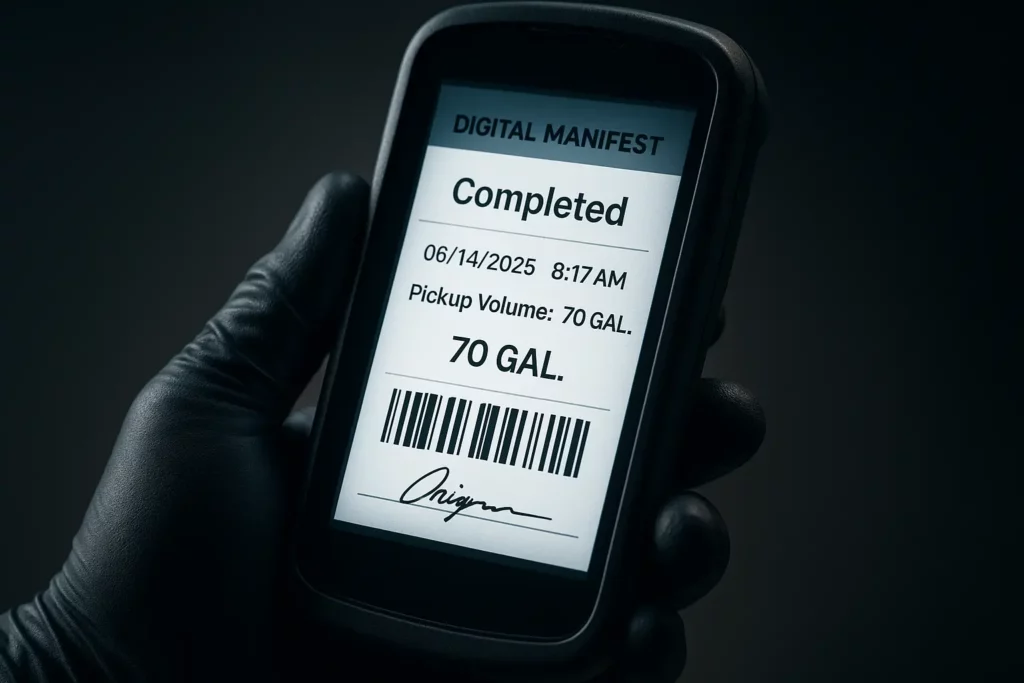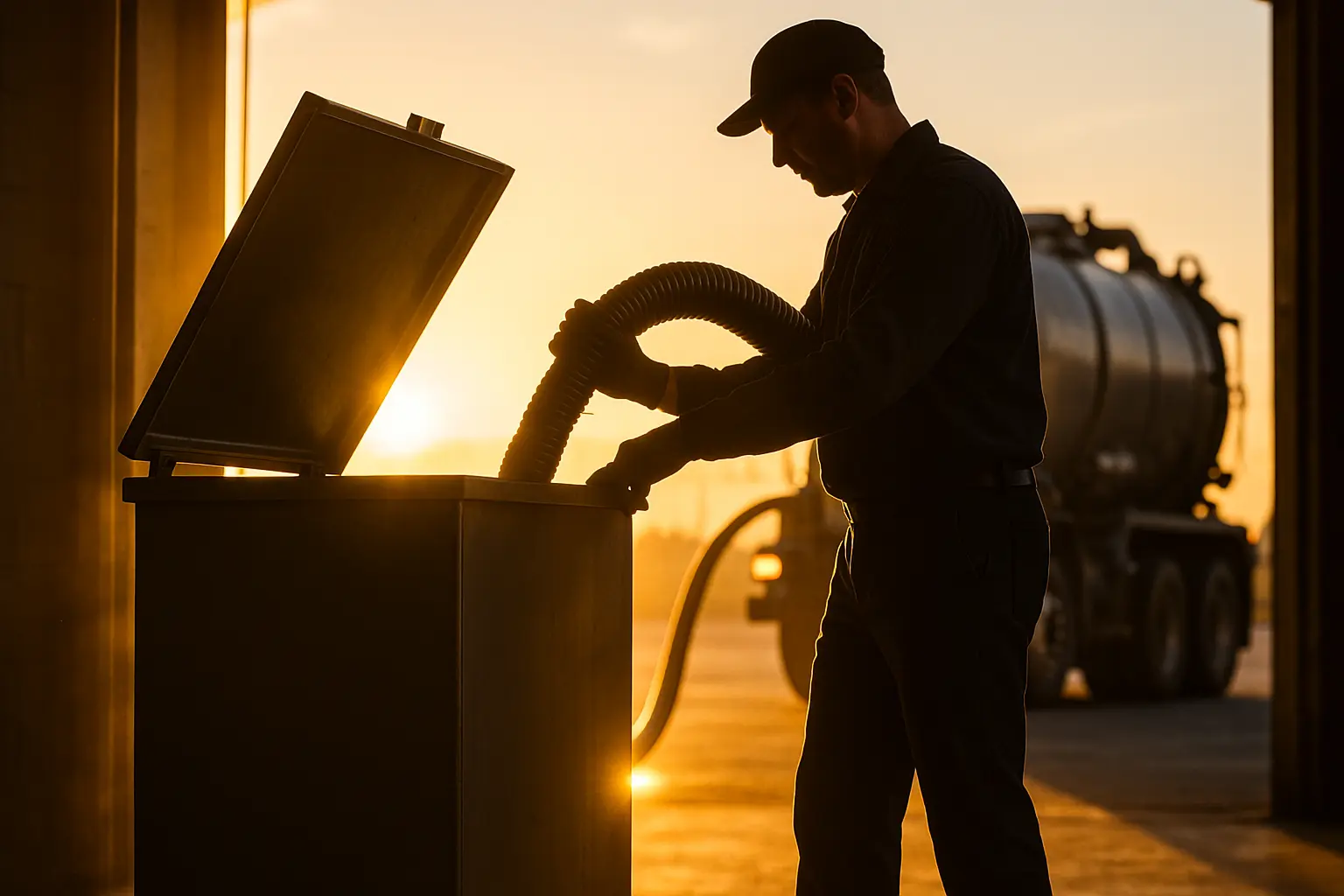Table of Contents
The Overlooked Engine of a Modern Kitchen
Walk into any busy line at 8 p.m. and you’ll see sizzling fryer baskets but rarely the quiet workflow humming beneath them. Regular pickup, daily for high volume chains, weekly for most independents, keeps that hum steady. Left unchecked, spent oil oxidizes, thickens, and overflows drums, inviting health department red flags. Predictable removal keeps aisles clear, staff focused on plating, not plunging buckets of hot grease into makeshift barrels. In the data pulled from our South Florida routes, kitchens that moved from on call to scheduled service saved an average twenty five minutes of labor per shift because cooks no longer paused to shuffle containers. Consistency, not heroic weekend purges, is what lets the line stay fast and inspections stay friendly.
Regulation & Reputation: Why Inspectors Look First at Your Drums
Fats Oils Grease (FOG) discharge rules vary by county, yet the pattern is constant: overflow equals violation. Municipal codes from Miami Dade to Camden mandate sealed containers and written pickup logs. A missed week can spill across the alley and down the storm drain, exposing the operator to hefty civil penalties and viral TikTok shaming. Regular manifests create an evidence trail that satisfies inspectors instantly; they scan the date, tick a box, and move on. In a year where local newsrooms increasingly scrape public health data for stories, staying off the list is free advertising. Your customers might never see the back door caddy, but city clerks and journalists will, and their opinion rides on a simple pickup schedule.
| Regulation Trigger | Potential Consequence |
|---|---|
| Overflow/Unsealed Container | Written notice, re inspection fee, public record |

Fire Safety & Hygiene: The Grease You Don’t See Can Ignite the Shift You Lose
Used oil degrades into polymerized sludge that clings to floors, soles, and fryer walls. Allow that layer to build and one dropped match, pilot flame, or spark from a frayed cord can flash a blaze in seconds. National Fire Protection Association case files show cooking media causes over one third of restaurant blazes. Regular pickup breaks the chain: less standing oil means fewer vapors, drier floors, and no improvised “grease corner” that breeds fruit flies by morning. Add the knock on benefits: reduced slip claims, lower workers’ comp premiums, and a kitchen that smells like dinner service rather than stale doughnuts, and the logic is unmistakable. Fire marshals notice the difference; so will your staff’s morale.
Operational Efficiency: Labor Minutes Become Marketing Dollars
Every quart of waste left overnight is a quart your staff must handle tomorrow. A fixed pickup cadence folds disposal seamlessly into closing tasks: cooks strain fryers, wheel the 70 gallon square caddy to the back dock, lock the lid, and clock out. When the truck arrives pre dawn, onboard pumps empty the tank in six minutes, deposit a digital service ticket, and go. Multiply that by 300 shifts and you reclaim dozens of labor hours, time you can reallocate to prep or social media content creation. On the cost side, fresh oil spend stabilizes because you’re no longer tempted to “stretch another day.” Predictable removal supports predictable purchasing, smoothing cash flow in a margin thin business.
Equipment Longevity: Protecting Fryers, Traps, and Floors
Fryer elements choke on polymerized debris, forcing them to overheat and trip breakers. Grease trap filters back up when excess oil migrates through floor drains. Regular pickup keeps holding containers manageable, so staff aren’t tempted to pour “just a splash” down the sink. That single habit can add a year to a fryer’s life and halve pump out frequency for grease interceptors. Our techs often spot early gasket leaks or burn marks while connecting hoses to a 140 gallon rectangular tank; they note it on the ticket, giving you a maintenance heads up you’d otherwise miss. In dollar terms, stretching a commercial fryer’s lifespan from five to seven years preserves roughly $4,000 in capex, money better spent on menu development.

Circular Economy & Guest Perception: Waste Into Renewable Fuel
Today’s diner cares where their food comes from and where its by products go. Collected oil is refined into low carbon biodiesel that powers delivery fleets and agricultural equipment, closing the loop between fryer and farm. Displaying a small “Your Fries Fuel Trucks” decal on the host stand turns routine waste management into a brand story guests remember, and post. It’s not just optics; many city RFPs for stadium concessions now score vendors on sustainability metrics. A verified pickup program backed by manifest data can tip a contract your way, proving you walk the talk on environmental stewardship.
How to Lock In a Bullet Proof Pickup Schedule
First, audit current volume: count drums, measure average daily yield. Second, match storage to flow: 55 gallon black drums suit bistros; high output venues need the 300 gallon automated system with pump cart and hose. Third, sync pickups to disposal capacity, leaving one third headroom for holiday spikes. Fourth, digitize manifests; many AI powered compliance portals now read QR codes on caddy lids, feeding data directly to your health inspection folder. Finally, train staff on a three step transfer routine: cool, filter, wheel. Reinforce with signage on the tank itself and quarterly refresher walk arounds. Scheduled service becomes muscle memory, freeing your team to focus on what they were hired to do: cook memorable food.









